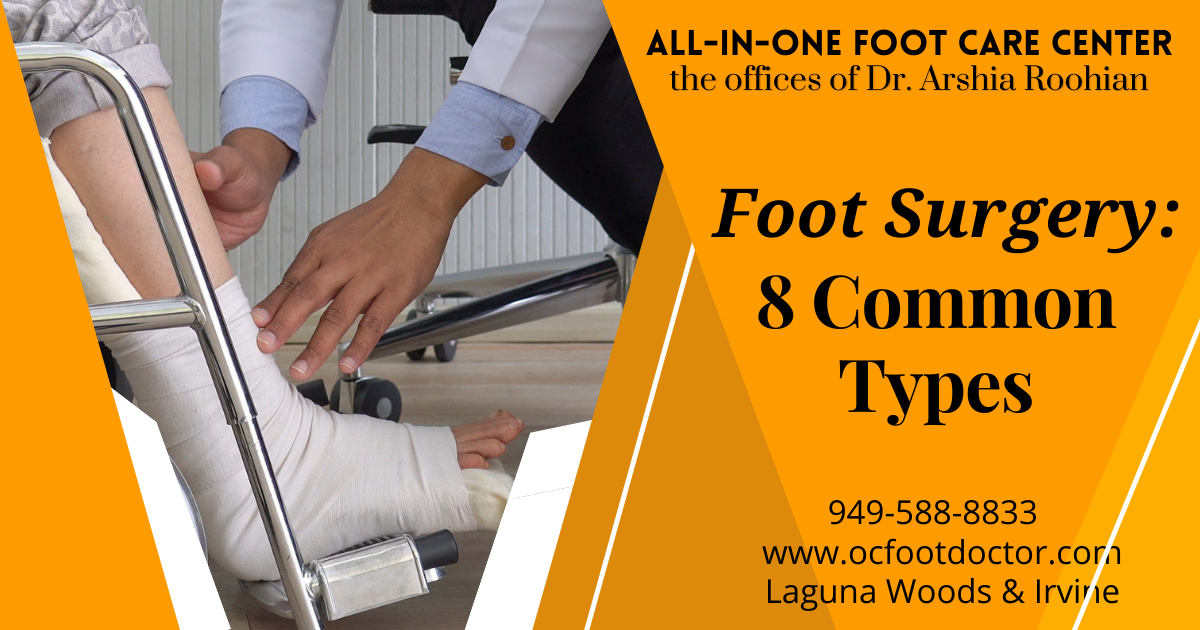Foot Surgery: 8 Common Types

It is no surprise that the feet and ankles are two of the most complex body parts. As a result, injuries or damage to these areas can occur in a variety of ways that can require surgery.
Foot and ankle surgeries come in a variety of forms.
- Metatarsal Foot Surgery
Five long bones form the metatarsals and are located on the bottom of the foot. In the forefoot, there are small joints, called metatarsophalangeal (or MTP) joints. When these become arthritic, the synovial lining of the joint can become inflamed, resulting in dislocation of the joints which can cause pain, discomfort, and the sensation of stepping on pebbles.
Specifics of the metatarsal foot surgery will depend on the severity of the injury. If the treatment is conservative and non-surgical, then Dr. Roohian and her team at All-in-One Foot Care Center will recommend it whenever possible, but the ultimate goal is to get you walking comfortably again.
Metatarsal injuries are often treated by removing the heads from the metatarsophalangeal joints and operating on the big toe. - Bunions Foot Surgery
There is a symptom known as "hallux valgus," which causes bony lumps at the base of the big toe. If the big toe bends towards the other toes, this condition causes the joint to become deformed. The result is bunions.
High heels are a major cause of female bunion problems, which are commonly caused by footwear choices. Bunions are not complicated to operate on. Bones are usually straightened by means of osteotomies, which take place on the big toe and metatarsals. Recovery time for bunion surgery takes about six weeks. - Hammertoe Foot Surgery
Hammertoe can also be caused by hallux valgus in addition to bunions. An individual with Hammertoe has a permanent bend in their toes. These deformed or clawed toes may result from Hammertoe.
Especially when walking, hammertoe is painful. Surgery can be used to correct this condition with an arthroplasty (a procedure that restores joint mobility) or an arthrodesis (removal of the deformed joint between your toes). They are often outpatient and take less than an hour to perform and although they sound extreme, they are relatively straightforward. In most cases, six weeks is the maximum period of recovery for hammertoe surgery. - Plantar Fasciitis Foot Surgery
Plantar fasciitis causes inflammation of the tissue at the point where the plantar fascia connects with your heel. This condition is rarely treated with surgery.
The plantar fascia is released from the heel bone as part of the plantar fasciitis surgery to relieve the tension and stimulate new growth in the fascia. In this situation, Dr. Roohian often recommends this surgery only when other treatments have proven ineffective. Depending on the type of surgery performed, plantar fasciitis surgery recovery times may vary. In the weeks following surgery, patients often need to wear a boot or special shoe. It may take a number of weeks for the patient to fully recover. - Ankle Arthritis Surgeries
Ankle surgeries are commonly performed for the following conditions:
As a result of excessive wear and tear, osteoarthritis occurs when the cartilage cushioning the ankle bones wears away and the bones rub against one another.
Ankle swelling, stiffness, and pain are physical symptoms of rheumatoid arthritis, an autoimmune disease in which the lining of your joints becomes inflamed, leading to inflammation.
The following surgical procedures can be used to treat ankle arthritis:
- Ankle Fusion
- Triple Fusion
- Ankle Replacement
In each case, Dr. Roohian will explain the procedure in detail and recommend the one that is right for your lifestyle. - Achilles Tendon Disorders
There is always activity in your Achilles tendon. This tendon provides you with support while walking, running, or moving around in general. A ruptured Achilles tendon (typically caused by wear-and-tear) can have dramatic consequences - including intense pain, swelling, and inability to walk normally.
The Achilles tendon can heal on its own if it has only a partial tear, which can be treated with nonsurgical options such as wearing a boot. Despite this, these methods are likely to cause slower recovery times and may even lead to recurrent tendon tears in older individuals. The Achilles tendon is often stitched back together by Dr. Roohian. Usually, it takes four to six months for a full recovery from Achilles tendon surgery. - Morton’s Neuroma Foot Surgery
Excessive thickening of the tissue around the nerves of the toes causes Morton's neuroma. In many cases, patients report feeling like they are walking on a pebble. Numbness or tingling in the toes as well as burning pain in the ball of the foot are other symptoms. Morton's neuroma requires surgery if it is severe and depending on the patient's lifestyle. Dr. Roohian offers nonsurgical treatment in over 80% of his cases. - Tibialis Posterior Dysfunction Foot Surgery
Your instep arch is supported by the tibialis posterior. Those muscles connect to the bone by means of the tibialis posterior tendon. In cases of injury (either through falling or overuse) to the tibialis posterior tendon, inflammation results in a swollen, painful foot arch.
Soccer and basketball players are among those who suffer from tibialis posterior dysfunction. The tibialis posterior dysfunction, if left untreated, may weaken the tendon and compromise the instep arch. "Flatfoot" is the result of this condition.
Surgery for tibialis posterior dysfunction can involve:
- Osteotomy
- Tendon transfer
- Fusion
After diagnosing the severity of your tibialis posterior dysfunction, Dr. Roohian will recommend a surgery that gets you back to doing the activities you love - pain-free!
Ready to schedule an appointment? All-in-One Foot Care Center is here to help! You can contact our office at 949-588-8833, or visit our website at https://www.ocfootdoctor.com. Our offices are located in Laguna Hills, Irvine, Mission Viejo, Aliso Viejo, Lake Forest, Foothill Ranch, and Costa Mesa.
📲 949-588-8833
🏢 24331 El Toro Rd, Suite 370 Laguna Woods CA 92637
🌐 https://www.ocfootdoctor.com/


